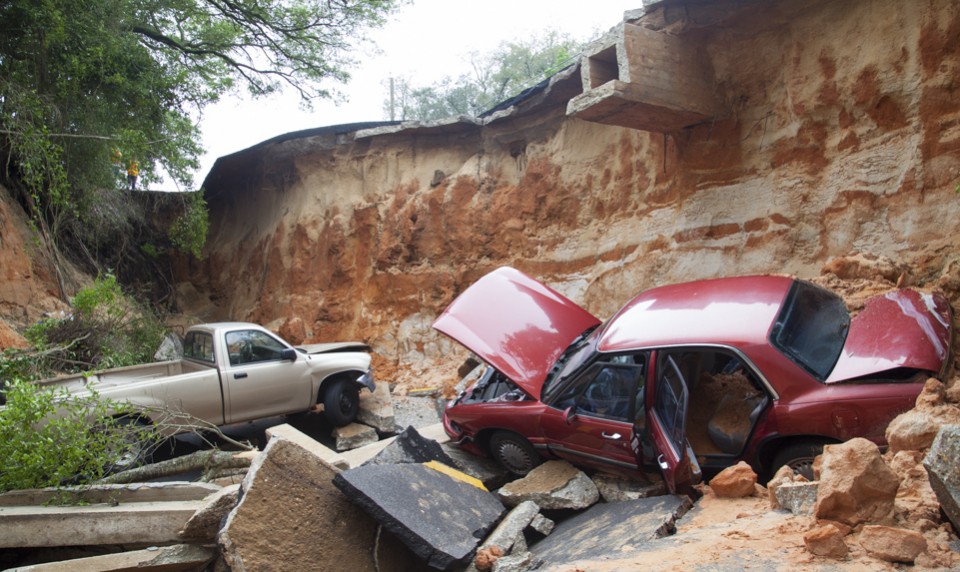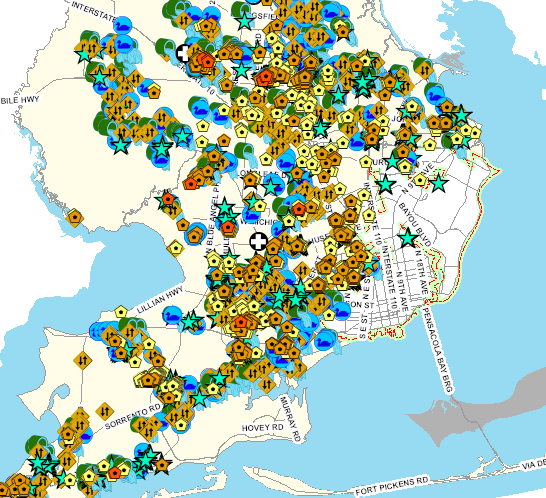New study examines public health effects of 2014 Escambia County flood
- September 19, 2016
- / Shannon Nickinson
- / early-learning

Record rainfall in 2014 compromised the road bed of Scenic Highway, resulting in two vehicles going over. Credit: Jim Edds.
University of West Florida researchers helped author a first-of-its-kind study that assessed the health effects of the devastating flood that struck the Pensacola area in April 2014.
Dr. Jason Ortegren, associate professor in the UWF Department of Earth and Environmental Sciences, and UWF graduate students Rebecca Foglietti and Talia Smith co-authored the health impact assessment with the Florida Department of Health and the Florida Environmental Public Health Tracking program.
The assessment covered the historic flooding that took place in Escambia County from April 28 to May 3, 2014.
The Florida Department of Health in Tallahassee received funding from the U.S. Centers for Disease Control and Prevention to conduct the study. The health impact assessment is the first of its type done by the Florida Environmental Public Health Tracking, said Chris DuClos, the program’s manager.
“We chose to collaborate with UWF because they provided local expertise in pulling and interpreting the precipitation data for Escambia County,” DuClos said.
Ortegren said the UWF team compiled much of the environmental data used in the assessment.
The study attempted to determine if there were increases in injury, illness and death as a result of the flooding, by comparing data on reportable diseases, hospitalizations, emergency department visits and deaths that occurred during the flooding event to a similar timeframe in 2008 where there was a normal amount of rainfall.
According to the report, the results of the comparison were “mixed, with some Escambia County ZIP codes showing increased hospitalizations and (emergency department) visits, and some ZIP codes showing a decrease.”
The report did show that, countywide, there were increases in the proportion of both “injury- and respiratory-related hospitalizations and (emergency department) visits” during the 2014 flooding period.
The health impact assessment includes several policy recommendations, including that electric panels on sewage lift stations be raised above the flood elevation in order to keep them operational during extreme rainfall events.
“The hopes are first, that some of the findings here actually help reduce health impacts if a similar event occurs in the future in Escambia County, or elsewhere,” Ortegren said. “Second, we hope that we have moved the (health impact assessment) experiment forward.”
For more information about the UWF Department of Earth and Environmental Sciences, visit uwf.edu/environmental.

 CivicCon launches with a look at good growth in cities
CivicCon launches with a look at good growth in cities
 Building stronger brains one baby, one parent at a time
Building stronger brains one baby, one parent at a time
 SCI debuts commercial on Early Learning City
SCI debuts commercial on Early Learning City
 Entrecon: World class speakers and an opportunity to sharpen skills
Entrecon: World class speakers and an opportunity to sharpen skills
 PYP Quality of Life survey 2017
PYP Quality of Life survey 2017
 EntreCon Pensacola 2016: A look back
EntreCon Pensacola 2016: A look back
 Leadership tip: getting better employee takeaways
Leadership tip: getting better employee takeaways
 Leadership tip: be interested instead of interesting
Leadership tip: be interested instead of interesting
 Leadership tip: delivering difficult messages
Leadership tip: delivering difficult messages
 Brain Bags boost Arc, Early Childhood Court programs
Brain Bags boost Arc, Early Childhood Court programs